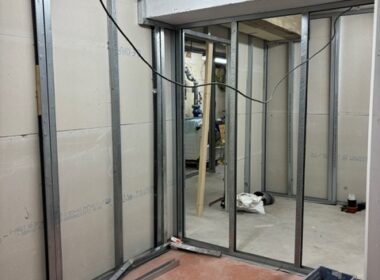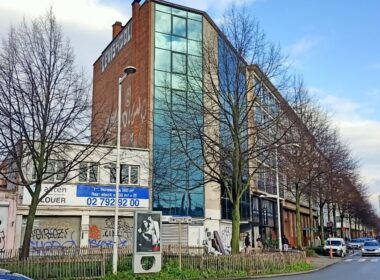The construction sector, still one of the most polluting in the world, needs to reinvent itself if it is to achieve its environmental objectives by 2030 and 2050. Given its impact on society and the environment, logistics is one of the main aspects in enabling the sector to make a successful sustainable transition. In Belgium, the construction sector accounts for 9 to 10% of workers, the vast majority of whom cannot work remotely. Similarly, the sector is responsible for almost 30% of the tonnage transiting through Brussels.
But things are starting to change in Belgium. Many players in Wallonia and Brussels are experimenting and innovating with logistics solutions. Ecobuild.brussels has decided to highlight some of these innovative solutions and initiatives and the people behind them who, in their own way and on their own scale, are demonstrating that it is possible to introduce logistics that combine sustainability and efficiency.
1. Kitting: confirmation of a model for scaling up to sector level
Buildwise, in collaboration with the logistics company Shipit and the general contractor BPC Group, recently launched an extensive study in Brussels into a solution known as kitting, i.e. the preparation of pallets of materials to be delivered Just in Time, Just in Place – via a decentralised logistics platform, often called a Construction Consolidation Centre, or CCC.
The aim of this study is to collect as much data as possible on the impact of kitting in urban construction projects, to confirm its economic and environmental added value and define a realistic and viable economic model that can be replicated on a larger scale. To do this, Buildwise has been monitoring two test projects since February and will continue for 30 months. BPC Group is acting as the general contractor and Shipit as the logistics manager. A third project, planned for 2025, is also part of the study.
How does kitting work for a construction project?
Kitting involves grouping into a single package a range of components from one or more suppliers and needed to carry out one or more tasks. The kits can then be delivered directly to the site concerned. The result is the Just-in-Time and Just-in-Place delivery of each intervention. Practically speaking, the suppliers transport the materials to the CCC, a veritable logistics hub, where agents assemble the kits. They are then sent to the site and delivered one by one to their exact destination, at the workstation.
There is only one centre of this type in Brussels, the Brussels Construction Consolidation Centre or BCCC, located at the Brussels ferry terminal, near Tour et Taxis, and operated by Shipit, one of the three players involved in this study.
Confirming hypotheses
Buildwise hopes that this study will confirm the added value of kitting in terms of productivity and environmental impact in the broadest sense.
Firstly, kitting reduces the number of delivery lorries on the roads, which in turn decreases the CO2 produced by transport. It also leads to a drop in noise pollution, traffic congestion and the use of public roads, since it reduces the need to store materials and park utility/delivery vehicles. “We used the Mobilise Centre at the VUB for the environmental part of the research project. We will provide them with a data set so they can analyse the environmental and social impact of kitting compared to a standard delivery model,” explains Sébastien Dandoy, R&D researcher at the Buildwise Sustainable Construction and Processes Department.
Secondly, kitting increases on-site productivity by freeing up space, encouraging better team co-activity and avoiding wasting time on operations with no added value, such as going back and forth to storage areas, or searching for a tool/material in these areas.
The Buildwise team is also hoping to confirm that the work will be less onerous for workers. Florent Suain, Logistics Consultant, “Just-in-Time, Just-in-Place delivery by a specialist logistician should significantly reduce the onerous nature of the job for workers, who will no longer have to move heavy loads from the storage area to the workstations and will be able to devote more time to productive tasks.
Constrains to consider
During these first months of testing on the BPC Group’s sites, Buildwise has already identified areas of tension for this study. Firstly, there is the issue of collecting measurable data, even if this has more to do with the project than the concept of kitting.
Secondly, in terms of implementing kitting in the construction sector, it is important to emphasise how hard it is for the logisticians. It is sometimes necessary to transfer heavy materials from the lorry to the freight lift, and then to the workstation itself,” explains Sébastien Dandoy. The Third-Party Logistics model must be increased and professionalised if the model is to be scaled up.
BIM: an additional solution?
Another Buildwise team will look at the potential of the BIM tool as kitting support: “Their objective is to determine the added value of BIM, in terms of organisation, identification of kits and their contents, and traceability. But this part of the research is still in its infancy,” concludes Sébastien Dandoy.
| Louis De Waele, who is also involved, has a longer-term view To develop new sustainable solutions, contractor Louis De Waele also took part in these test sites, as part of the temporary partnership with the BPC Group. For these projects, the materials were delivered by inland waterway, Just-in-Time, Just-in-Place. Marc Vanderick, Quality and Environment Manager at Louis De Waele, gives an encouraging initial assessment, “The results have been particularly satisfactory, and the impact of these logistics is huge. It reduces the carbon impact of transport and helps to relieve congestion in the capital. It also limits the easement and storage areas required on site and makes it easier to set up a more organised waste sorting station.” Louis De Waele is also carrying out a feasibility study on this station and the return of waste to the BCCC via the delivery convoy, thus avoiding empty journeys. This would close the logistics loop. This project to develop our reverse logistics is still in its infancy; we are examining potential solutions for ourselves and our site partners,” he adds with caution. Although Louis De Waele needs more time to decide whether this circular loop is economically viable, the contractor is delighted with the buzz around the BCCC, which offers new opportunities for the construction sector in Brussels: “The presence of a player like the BCCC offers the potential for a modal shift, which could prove extremely beneficial for construction activities in urban areas. It also creates the possibility of new synergies between different players, who are able to rationalise and above all collectivise their logistics,” he concludes. |
2. Acting locally: the example of Bru Co Creation
However, making logistics more sustainable and rationalised is not a luxury reserved for multinationals and large contractors. Yannick Warnau, manager of Bru Co Creation, a small construction company, has been making most of his business trips by cargo bike since 2022. This is a logistical solution he cannot do without today: “There is no doubt that the cargo bike makes my business more efficient and therefore more profitable.”
After working as a site manager for a major construction company, Yannick Warnau decided to launch his own construction company in 2019. Thanks to the support of the non-profit JobYourself[1], he was referred to Embuild’s support service, BuildCircular.
“BuildCircular showed me that my social and environmental values were in line with those of the circular economy. I decided to transpose them into my independent contractor business, particularly by emphasising the re-use of materials and efficient waste management.”
Today, he wears several hats: general contractor and company manager, as well as business coach and consultant to individual self-builders. Importantly, the Jette-based contractor decided to limit his activities to the local, or even ultra-local level: “From the start, I wanted to restrict our work to Jette and the surrounding municipalities, such as Laeken, Ganshoren and Molenbeek.”
To make his personal and professional life easier, he acquired a cargo bike through the Cairgo Bike programme run by Brussels Environment:
The financial aid of this 2,500 euros grant encouraged me to take the plunge in 2021. Since then, I’ve used it for a large amount of my private travel and for most of my business trips. Site visits, minor works and, where possible, some equipment deliveries. For deliveries, I am of course limited, if only by the weight or dimensions of certain materials. I therefore recommend having a utility vehicle in addition to a cargo bike, to avoid logistical problems.”
Benefits across the board
When asked how he assesses this new logistics organisation, Yannick Warnau has an unequivocal answer: “I don’t think I could do without it today. The cargo bike has significantly increased my efficiency, with less time wasted in traffic and looking for parking and/or unloading spaces. My logistics costs have also decreased, as I pay less for fuel and other costs, such as parking, fines and maintenance.”
While he is pleased with the benefits for his business, the contractor also highlights the personal benefits of the cargo bike, such as daily physical activity and stress reduction.
This decision is, of course, in line with his desire to ensure his company has an impact on the environment.
In addition to the benefits already mentioned, I have the satisfaction of knowing that I am taking positive action to support the environment. I think that some entrepreneurs do not really realise the time savings this type of logistics solution can allow. I can only recommend that they take the plunge, and I think that travel is a key aspect where it is easy to take action, even for SMEs and start-ups,” he concludes.
In his own way, Yannick Warnau is involved in the sustainable transition of the construction sector, but most importantly, he is showing by example that every company, whether large or small, can make a contribution.
Time to spread these virtuous practices
These players are demonstrating on their respective scales the diversity of the rational and sustainable logistics solutions available to all businesses, from the largest to the smallest. While these initiatives remain specific to certain innovative companies, their feedback could encourage other sector players to develop a sustainable logistics approach. The collectivisation of logistics activities already appears to be a solution for the future, with strong economic and environmental potential. The pilot project of the BCCC, now a recognised player in Brussels, should also be a driving force for initiatives to collectivise construction logistics and encourage a modal shift.
Likewise, the initial results of studies carried out by specialist institutions such as Buildwise should provide quantified data on the economic, social and environmental impacts, which in turn could motivate other construction companies to realise the economic viability of these innovative solutions.
[1] More specifically JobYourself Bati Crea, one of the two cooperatives it supports.





